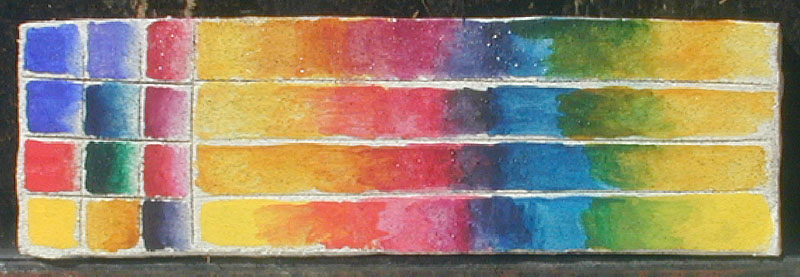|
01-15-04, On a 1/2 inch thick brick tile, a base coat of 1:2 lime-sand.
The top coat is 1 sand, 1 marble meal, 2 week old slaked lime. This is a test chart of chemical colors for fresco plus cadmium yellow, cadmium red and ultramarine blue. 1, PY108 transparent yellow Br/s, PR122 transparent cool magenta, PB15 transparent cyan, this combination made a good blue red and orange, the green's are dirty. 2. PY108, PV19, PB15, this combination made a good red, poor blue and purple. 3. PY108, alizarin crimson synthetic made good orange and red.
Day 2, PV19 is changing on line four, the cad. red to magenta PR122 blend was painted evenly.
In the color swatches, all the colors did well except PV19, a Rembrandt Rose hue that fades.
Gradation Rows #1 and #3 are great. A 3 color fresco is possible with chemical colors. And it is going to be fun! All the colors got a little paler and truer. PY108 Indian Yellow did great. PR122 Quinacridone Magenta Y is a beautiful warm magenta, making good reds, oranges and blues. PR122 mixed with Indian yellow made a color similar to alizarin crimson. Alizarin Crimson changes color in fresco. PB15 cyan is so perfect in fresco, making blues and greens with ease. Sinopia calls it PB15.3, don't buy their other PB15's, I didn't like their colors. Liquitex and Grumbacher call cyan PB15. PV19, Rembrandt Rose in w/c, fades badly in lime.
Row 1. ultramarine blue light, cobalt blue deep, alizarin crimson.
For more about chemical colors, go here.
For a watercolor painting using just those 3 pigment colors go here. TIP = 01-15-04 Calcium carbonate is a hard shiny surface that's hard to stick to so cracks are bound to happen on added mortar layers. Diluted vinegar will remove the calcium carbonate but it's an acid that has to be neutralized with baking soda. NEXT FRESCO PAGE #12 Fresco, Alcohol, Ammonia, Egg, Casein, fresco7alcammeggcas.htm PREVIOUS FRESCO PAGE #10 Mortar Pressure Shine, fresco5maincolorchart.htm
END PAGE End Page
|

3 Frescos 1 DVD $35
5"x5" Laminated Real Color Wheel $10.00.

